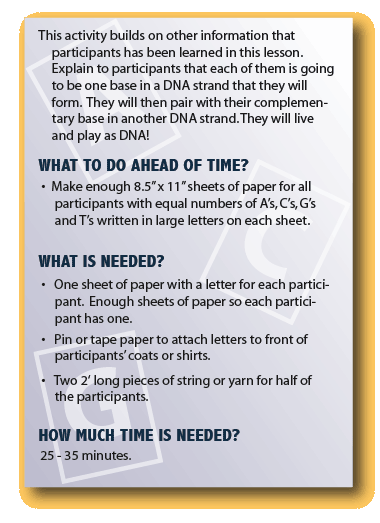
Dessert: Live and Play DNA

Directions
Ask each participant to take one letter and either pin or tape it to the front of their coat or shirt. Make sure that there are equal numbers of complimentary bases. That is, the same number of A's and T's and the same numbers of G's and C's so that all participants will be able to pair with their "compliment".
Have participants stand in a long line. The two lines must have equal numbers of A's to match with T's in the other line, G's to match with C's, etc. The leader reminds participants that chromosomes have two complementary strands. The bases in the DNA, A's, T's, G's and C's, link to each other in one strand and then pair with their complementary base in the other strand. Ask half of the participants to line up randomly in a straight line, making sure that there are equal numbers of A's in the first line to match with the same
number of T's in the second line; the same number of G's in the first line to match with equal numbers of C's in the second line, etc.To simulate that the bases in each strand link to each other, ask participants in the first line to link elbows tightly with the other "bases" in their line. Once the line is linked, ask the second set of participants to find their complementary base in the first line: "A" finds a "T" and "G" finds a "C". When they find their complementary base,
ask them to stand directly across from the base and also link elbows with the other "bases" in their line.
In the two complementary strands that form DNA in an organism, the two complementary bases in the opposite strands pair with each other. To simulate that, hand each participant in the first line 2 pieces of string, one for each hand. Ask participants with complementary bases, standing across from each other, to grab the ends of the two strings being held by their complementary base. Each line should continue to lock elbows.
- Speculate as to which bond in the DNA you think might be stronger – the one linking the backbone (locking elbows) or the pairing between bases (holding the strings)?
- If only one strand of DNA is copied to make RNA, can you guess what must happen to the base pairing in order for copying to occur?
Have everyone take a step to their right. Instruct participants to grasp hands of the person in front of them only if that person is a complementary base.
- Describe what you think happened to the strength of the bonding in the backbone when you moved to the right?
- Describe what you think happened to the bonding of the complimentary bases when you moved to the right? Tip to Leader: The bonds between the bases in the backbone (elbows linked) are covalent bonds that are stronger than the hydrogen bonding (strings held) that takes place between complimentary bases. Those bases must come apart when DNA is replicated but the bonds in the backbone do not.
Special thanks to Jenne Stonaker for providing the idea for the "Live and Play DNA" activity.
Next: Stuffed, but Hungry for More?